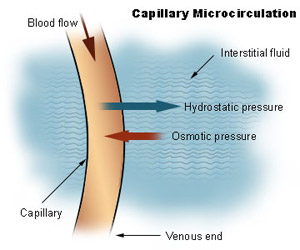Physiology of Circulation
Roles of Capillaries

In addition to forming the connection between the arteries and veins, capillaries have a vital role in the exchange of gases, nutrients, and metabolic waste products between the blood and the tissue cells. Substances pass through the capillary wall by diffusion, filtration, and osmosis. Oxygen and carbon dioxide move across the capillary wall by diffusion. Fluid movement across a capillary wall is determined by a combination of hydrostatic and osmotic pressure. The net result of the capillary microcirculation created by hydrostatic and osmotic pressure is that substances leave the blood at one end of the capillary and return at the other end.
Blood Flow
Blood flow refers to the movement of blood through the vessels from arteries to the capillaries and then into the veins. Pressure is a measure of the force that the blood exerts against the vessel walls as it moves the blood through the vessels. Like all fluids, blood flows from a high pressure area to a region with lower pressure. Blood flows in the same direction as the decreasing pressure gradient: arteries to capillaries to veins.
The rate, or velocity, of blood flow varies inversely with the total cross-sectional area of the blood vessels. As the total cross-sectional area of the vessels increases, the velocity of flow decreases. Blood flow is slowest in the capillaries, which allows time for exchange of gases and nutrients.
Resistance is a force that opposes the flow of a fluid. In blood vessels, most of the resistance is due to vessel diameter. As vessel diameter decreases, the resistance increases and blood flow decreases.
Very little pressure remains by the time blood leaves the capillaries and enters the venules. Blood flow through the veins is not the direct result of ventricular contraction. Instead, venous return depends on skeletal muscle action, respiratory movements, and constriction of smooth muscle in venous walls.
Pulse and Blood Pressure
Pulse refers to the rhythmic expansion of an artery that is caused by ejection of blood from the ventricle. It can be felt where an artery is close to the surface and rests on something firm.
In common usage, the term blood pressure refers to arterial blood pressure, the pressure in the aorta and its branches. Systolic pressure is due to ventricular contraction. Diastolic pressure occurs during cardiac relaxation. Pulse pressure is the difference between systolic pressure and diastolic pressure. Blood pressure is measured with a sphygmomanometer and is recorded as the systolic pressure over the diastolic pressure. Four major factors interact to affect blood pressure: cardiac output, blood volume, peripheral resistance, and viscosity. When these factors increase, blood pressure also increases.
Arterial blood pressure is maintained within normal ranges by changes in cardiac output and peripheral resistance. Pressure receptors (barareceptors), located in the walls of the large arteries in the thorax and neck, are important for short-term blood pressure regulation.
